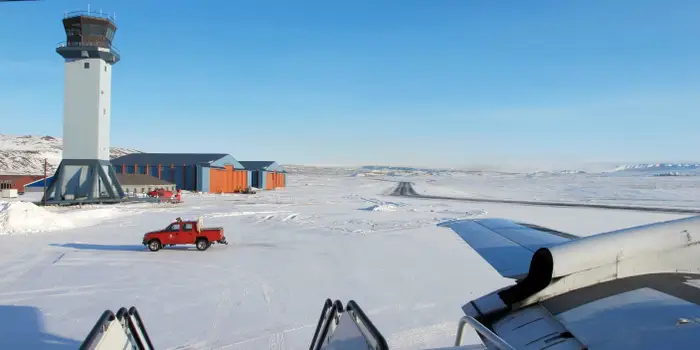High in the Arctic Circle lies one of the most remote and strategic U.S. military installations: Pituffik, formerly known as Thule Air Base.
Perched on the frozen shores of Greenland, it serves as a vital outpost for missile defense, satellite monitoring, and Arctic operations.
This article covers everything you need to know about Pituffik, including its:
1. History and renaming
2. Strategic mission
3. Life at the base
4. FAQs and interesting facts
Let’s explore this extraordinary location.
Table of Contents
What is Pituffik (Thule Air Base)?
Pituffik Space Base, until recently called Thule Air Base, is the northernmost U.S. military base, situated about 750 miles north of the Arctic Circle in northwestern Greenland.
It is operated by the United States Space Force (USSF) under the Peterson-Schriever Garrison.
Pituffik plays a critical role in:
Ballistic missile early warning
Satellite command and control
Space surveillance
Strategic Arctic presence
Why the Name Change to Pituffik?
In April 2023, the U.S. renamed Thule Air Base to Pituffik Space Base in recognition of Greenland’s indigenous heritage.
“Pituffik” means “the place where they tie the dogs” in Greenlandic.
The name reflects respect for the local Inuit communities, who lived and hunted in the area long before the base was built.
History of Thule Air Base / Pituffik
Early History
Greenland was a Danish territory during World War II, and the U.S. established weather stations and airfields on the island to monitor German activities.
In 1941, the U.S. and Denmark signed an agreement allowing American bases in Greenland.
Building Thule Air Base
Construction of Thule began in 1951 during the Cold War.
At its peak, it hosted thousands of personnel and a vast infrastructure to support B-52 bombers and radar systems.
It became a linchpin in the Distant Early Warning (DEW) Line — a radar network designed to detect Soviet bombers and missiles.
Cold War and Beyond
The base’s importance grew as a missile-warning and satellite-tracking facility.
Today, it continues to provide critical surveillance and support U.S. and NATO operations in the Arctic.
Location & Environment
- Coordinates: 76°32′N 68°42′W
- Climate: Extreme Arctic — temperatures as low as -30°F (-34°C), with months of continuous daylight in summer and darkness in winter.
- Surroundings: Ice caps, glaciers, and stunning yet harsh landscapes dominate the region.
The base is only accessible by air most of the year and via ship during a brief summer window when sea ice recedes.
Mission & Strategic Importance
Pituffik remains essential for U.S. national security and Arctic strategy.
Its key missions include:
- Missile Warning: Radar systems detect ballistic missile launches from Russia, China, or elsewhere.
- Space Domain Awareness: Tracking satellites and debris in Earth’s orbit.
- Satellite Operations: Ground stations communicate with satellites, providing data and command functions.
- Support for Arctic Operations: Staging point for search & rescue, scientific research, and military missions.
Life at Pituffik
Living and working at Pituffik is a unique experience:
Personnel: Typically ~150–200 military and civilian personnel.
Housing: Dormitory-style rooms with communal dining and recreation areas.
Activities: Gym, bowling alley, movie nights, and Arctic hikes.
Challenges: Isolation, extreme cold, limited daylight (or too much of it).
It’s not for everyone—but for those who serve there, it’s a memorable and meaningful assignment.
Facilities and Capabilities
- Radar Systems — For early missile and space threat detection.
- Satellite Tracking Stations — Communicate with U.S. and allied satellites.
- 10,000-foot Runway — Can accommodate large cargo and tanker aircraft.
- Support Facilities — Dining, healthcare, gym, and morale services.
Interesting Facts about Pituffik
1. The northernmost base in the U.S. military’s network.
2. Originally designed to host nuclear bombers during the Cold War.
3. The base’s name reflects Greenlandic dog-sledding traditions.
4. Accessible by ship only during a short summer “sealift” window.
5. Experiences polar day (24-hour sunlight) and polar night (24-hour darkness).
FAQs About Pituffik (Thule Air Base)
Q1: Where is Pituffik located?
In northwestern Greenland, above the Arctic Circle — one of the most remote U.S. bases.
Q2: Why was it called Thule Air Base?
“Thule” was a name chosen by U.S. forces, referencing ancient explorers’ term for a far-northern land.
Q3: When was it renamed Pituffik?
In April 2023, to honor Greenlandic heritage.
Q4: What is the mission of Pituffik?
To provide missile warning, satellite control, and space surveillance.
Q5: Who operates the base?
The United States Space Force (USSF), part of the U.S. Department of Defense.
Q6: Can civilians visit the base?
No. Access is restricted to military and authorized personnel only.
Q7: How do you get there?
Primarily by U.S. Air Force flights from other bases; ships bring supplies during the summer.
Q8: How many people are stationed there?
Usually between 150–200 personnel, though thousands lived there during its peak in the Cold War.
Final Thoughts
Pituffik (formerly Thule Air Base) is more than just a military base — it’s a symbol of U.S. commitment to Arctic security, space operations, and partnership with Greenland.
Its history spans decades of strategic importance, from the Cold War to today’s space-focused missions.
While remote and harsh, it remains a cornerstone of national defense and an extraordinary example of human resilience in the Arctic.
Key Takeaways
- Pituffik is the northernmost U.S. military base, located in Greenland.
- Formerly known as Thule Air Base, renamed in 2023 to honor local culture.
- Critical for missile warning, satellite operations, and space surveillance.
- Home to dedicated personnel working under extreme conditions.












